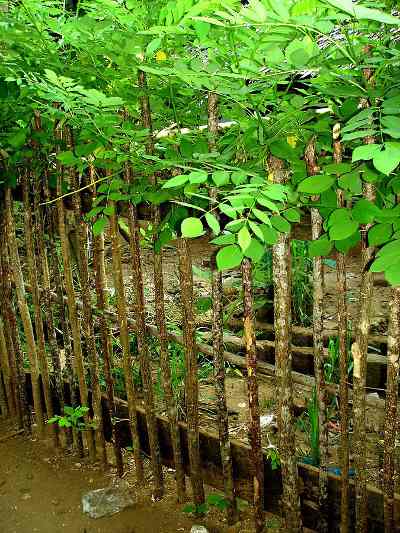Grow A Living Fence

One such tool is fencing. Fencing provides barriers, visible boundaries and protection from the elements. Modern fences may be made from metal, but you can make your own fence without any such material. Not only that, but what if I told you your fence could actually be better than a modern counterpart because yours can actually serve a dual purpose of providing a barrier as well as food and maybe more!
I am talking about a living fence. A fence composed not of metal, but instead of living plants, managed explicitly to serve as a barrier.
Living fences may be a new concept to us in the USA but actually living fences have been used here and overseas for centuries. After a SHTF event happens, relearning some of the old ways can be of great use.
A living fence is a permanent plant barrier that is tight enough to function like a modern fence would. Depending on the species you choose, a living fence can also provide food or medicine, and shade.
Some of the possible additional benefits of a living fence over a modern metal fence are nitrogen fixing, windbreak, shade, food, forage, wind erosion reducer, water erosion reducer, fuel as well as aesthetics.
To grow a living fence you must plant a lot of seeds. Obviously you plant them exactly where you want your fence to be. Spacing must be tight to ensure your barrier is dense enough to serve your purpose. The living fence work for you is not done however. As the plants grow there are methods to make them more effective.
One technique is to weave and tie the branches of the plants together. When this is done the plants will actually grow together at that point and become joined. For this to work the place of joining must be secured in a manner that allows no movement. Any movement will prevent the joint from growing together. Even if the plants do not join and become one, the weaving of the limbs may still serve the same purpose as the plants grow and the weaved branches get stouter and less wispy.
Another technique you may need to use is trimming or topping. Many species will lose their lower branches as they grow taller. To prevent this from happening you can either cut the larger plants so that they sprout back from the stump or simply trim the tops so that the plants are not allowed to grow taller than 5 or 6 feet tall. This continuing process of trimming will cause the plants to bush out instead of growing tall.
Establishing a living fence can be labor-intensive but maintaining modern fences is also going to be more work than a city slicker might realize. If you have any significant amount of fence, you will quickly learn that nature is constantly trying to destroy it, with fallen trees and big limbs being the main culprit.
Hopefully your living fence will provide you with some shade and possibly a meal as you tend to its needs.
